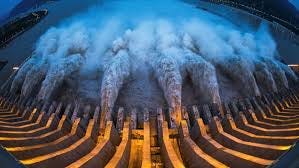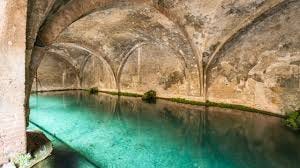The Water Which Feeds the Roots of All Evil
More on Ruskin and Irrigation: from the the Hydraulic Empires to Fonte Branda and the Rivers of Paradise.
THERE IS NO WEALTH BUT LIFE. Life including all its powers of love, of joy, of admiration.
So, in thumping block caps, John Ruskin threw down his challenge to the economic thought of his age. This resounding blast of the trumpet is from Unto this Last – Ruskin’s most radical, root-and-branch assault on laissez-faire capitalism and the tenets of that ‘true science of darkness’, political economy. It’s a dazzlingly eloquent performance and still, I think, poses questions that the more dogmatic forms of free-market ideology fail to address. But given my riverine theme, the bit I’m going to focus on is a long passage in which Ruskin attacks popular notions of supply and demand – especially the idea that these are forces beyond human law or direction. His choice of metaphor will be familiar to anyone who has been following these posts.
The popular economist thinks himself wise in having discovered that wealth, or the forms of property in general, must go where they are required; that where demand is, supply must follow . . . Precisely in the same sense, and with the same certainty, the waters of the world go where they are required. Where the land falls, the water flows.
The course neither of clouds nor rivers can be forbidden by human will. But the disposition and administration of them can be altered by human forethought. Whether the stream shall be a curse or a blessing, depends upon man’s labour, and administrating intelligence. For centuries after centuries, great districts of the world, rich in soil, and favoured in climate, have lain desert under the rage of their own rivers; nor only desert, but plague-struck. The stream which, rightly directed, would have flowed in soft irrigation from field to field . . . now overwhelms the plain, and poisons the wind; its breath pestilence, and its work famine. In like manner this wealth ‘goes where it is required.’ No human laws can withstand its flow. They can only guide it: but this, the leading trench and limiting mound can do so thoroughly, that it shall become water of life . . . or, on the contrary, by leaving it to its own lawless flow, they may make it, what it has been too often, the last and deadliest of national plagues: water of Marah — the water which feeds the roots of all evil.
Ruskin’s hydraulic metaphors can, however, be read in a very different direction. The history of big water projects, ancient and modern, suggests that there is indeed a connection between irrigation and social organization – but that it is often a much darker one than Ruskin supposed.
The history of big water projects, ancient and modern, suggests that there is indeed a connection between irrigation and social organization – but that it is often a much darker one than Ruskin supposed.
Writing in the 1950s, the US historian Karl Wittfogel identified a specific type of society that he termed a ‘hydraulic empire’ – a state characterized by massive irrigation projects and government control of water. These empires had one other feature in common: they were all despotisms of the most extreme and murderous kind. In ancient Egypt or Mesopotamia, the prototypes of the hydraulic state, the system of irrigation and flood control required both a large, absolutely obedient workforce and a highly centralized system of command. The ‘hydraulic dynasts’ built not only their power but also much of their mystique on what must have seemed a near supernatural command of the elements.
Provocatively, Wittfogel went on to identify many of the same features in communist China and Russia, arguing that the vast hydraulic schemes undertaken in these countries served chiefly to legitimize the state by asserting its brute mastery over nature. In the words of Simon Schama, who summarizes Wittfogel’s hydraulic thesis in his Landscape and Memory:
The colossal dam and the hydroelectric power station as emblems of omnipotence were for modern despots what the Nile irrigation canals were for the Pharaohs. Steaming along the Volga-Don canal to which countless thousands of slave labourers had been sacrificed, Stalin could proclaim himself the master of the waters. Breasting his way down the Yangtze, at the head of regiments of the swimming proletariat, Mao Tse-tung could affirm that he was indeed the fluvial Emperor of the Masses: unsinkable, indestructible, immortal. And through the Three Gorges Dam, flooding the most famous icon of all China's river landscapes, Deng Xioping tried to present himself in succession to the founder of the very first dynasty . . . the semilegendary emperor Yu . . . whose authority was established on his mastery of the flood and the establishment of intensive, irrigated agriculture.
The human and environmental costs of Big Water are also set out in Fred Pearce’s 1992 polemic The Dammed, which follows Wittfogel in seeing the Soviet water programme as chiefly a demonstration of state power. According to one (dissident) Soviet official quoted in the book, ‘The more such projects contradicted the laws of nature, the more highly they were regarded.’ In effect, nature was seen as an unruly or even pathological condition that could only be cured through a policy of shock and awe: Maxim Gorki, in his last years a grisly apologist for Stalin, eulogized the hydroelectric programme as a heroic attempt to make ‘mad rivers sane.’ As Pearce also points out, Hydroproject, the Soviet dam-building agency, was until 1960 a subdivision of the NKVD: the huge labour force needed to build the Russian mega-dams could only be provided from one source – the gulags.
For what it’s worth, these seem to me perhaps the most moving and mysterious sentences in the language.
From which things back to John Ruskin, digger of ditches and bender of streams, as he delves into his own rapidly crumbling memory in the study at Brantwood, in the early summer of 1889. That June Ruskin surfaced temporarily from the madness that had long engulfed him and was able to dictate the paragraphs that would stand as the final pages of Praeterita, his wondrous meandering maddening memoir. An account that began among the ‘rivers of Paradise’ in Croydon and Carshalton winds to a close with memories of another lost Eden, the calm period in middle age when Ruskin had moved back to his childhood home at Denmark Hill in South London. The ‘Joanie’ mentioned here is Joan Severn, the cousin who cared for him in his angry, baffled dotage, and ‘Rosie’ is Rose La Touche, the disturbed young woman who had been at the centre of his obsessions for almost three decades. Although he speaks of Rose in the present tense, in 1889 she had been dead for 14 years.
I draw back to my own home, twenty years ago . . . and the Elysian walks with Joanie, and Paradisiacal with Rosie, under the peach-blossom branches by the little glittering stream which I had paved with crystal for them. I had built behind the highest cluster of laurels a reservoir, from which, on sunny afternoons, I could let a quite rippling film of water run for a couple of hours down behind the hayfield, where the grass in spring still grew fresh and deep. There used to be always a corncrake or two in it. Twilight after twilight I have hunted that bird, and never once got glimpse of it: the voice was always at the other side of the field, or in the inscrutable air or earth. And the little stream had its falls, and pools, and imaginary lakes. Here and there it laid for itself lines of graceful sand; there and here it lost itself under beads of chalcedony. It wasn’t the Liffey, nor the Nith, nor the Wandel; but the two girls were surely a little cruel to call it ‘The Gutter’! Happiest times, for all of us, that ever were to be . . . I have been sorrowful enough for myself, since ever I lost sight of that peach-blossom avenue. ‘Eden-land’ Rosie calls it sometimes in her letters. Whether its tiny river were of the waters of Abana, or Euphrates, or Thamesis, I know not, but they were sweeter to my thirst than the fountains of Trevi or Branda.
Here the fluvial imagery that streams and dances through Praeterita wells up limpidly for one last time. The Trevi fountain in Rome needs no gloss; Fonte Branda is the beautiful 13th-century fountain in Siena that provided the city with most of its drinking water in the Middle Ages and still offers the tourist a haven of coolness and peace (for what it’s worth, this is my favourite spot in perhaps my favourite city). Memories of Siena swirl up in Ruskin’s mind as he constructs the last sentences that he would ever write, before madness closed finally over his head. (Again, for what it’s worth, these seem to me perhaps the most moving and mysterious sentences in the language.)
How things bind and blend themselves together! . . . Fonte Branda I last saw with Charles Norton, under the same arches where Dante saw it. We drank of it together, and walked together that evening on the hills above, where the fireflies among the scented thickets shone fitfully in the still undarkened air. How they shone! moving like fine-broken starlight through the purple leaves. How they shone! through the sunset that faded into thunderous night as I entered Siena three days before, the white edges of the mountainous clouds still lighted from the west, and the openly golden sky calm behind the Gate of Siena’s heart . . . and the fireflies everywhere in the sky and cloud rising and falling, mixed with the lightning, and more intense than the stars.
How things bind and blend themselves together!
This piece was originally posted on the Dabbler blog in July 2012, as part of a short series about John Ruskin and his fascination with rivers and irrigation. The other parts are: 1. Ruskin and the River and 2. Ruskin the Irrigationist.
If you enjoyed this post, you might be interested in my ebook The Whartons of Winchendon — a short study of one of the strangest families in English history, featuring incest, treason, deep-sea diving, fairies, and the self-proclaimed Solar King of the World.





